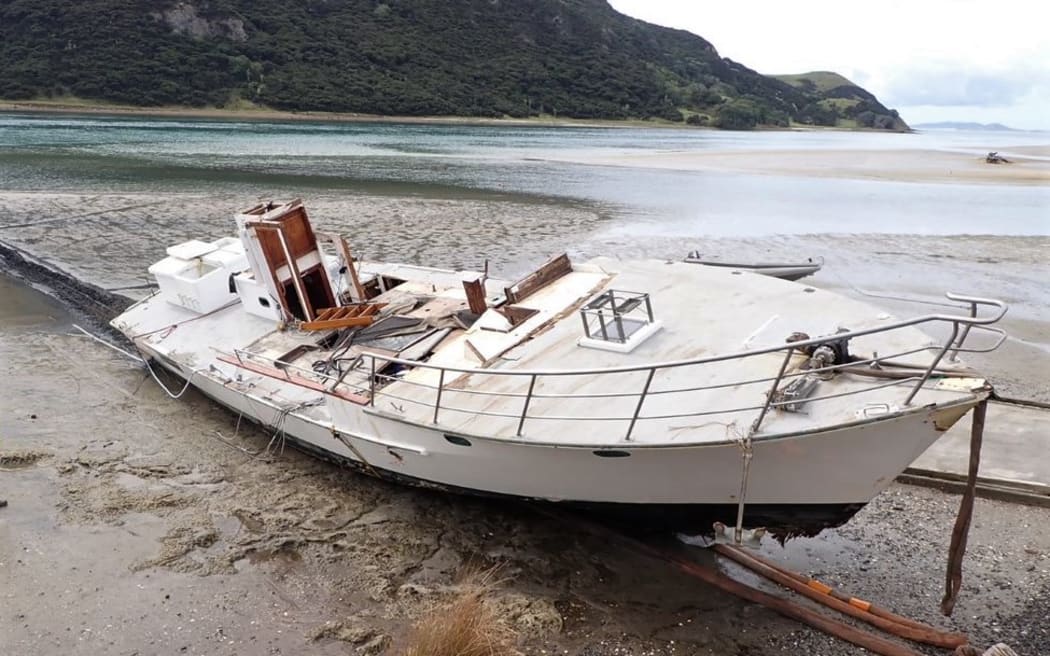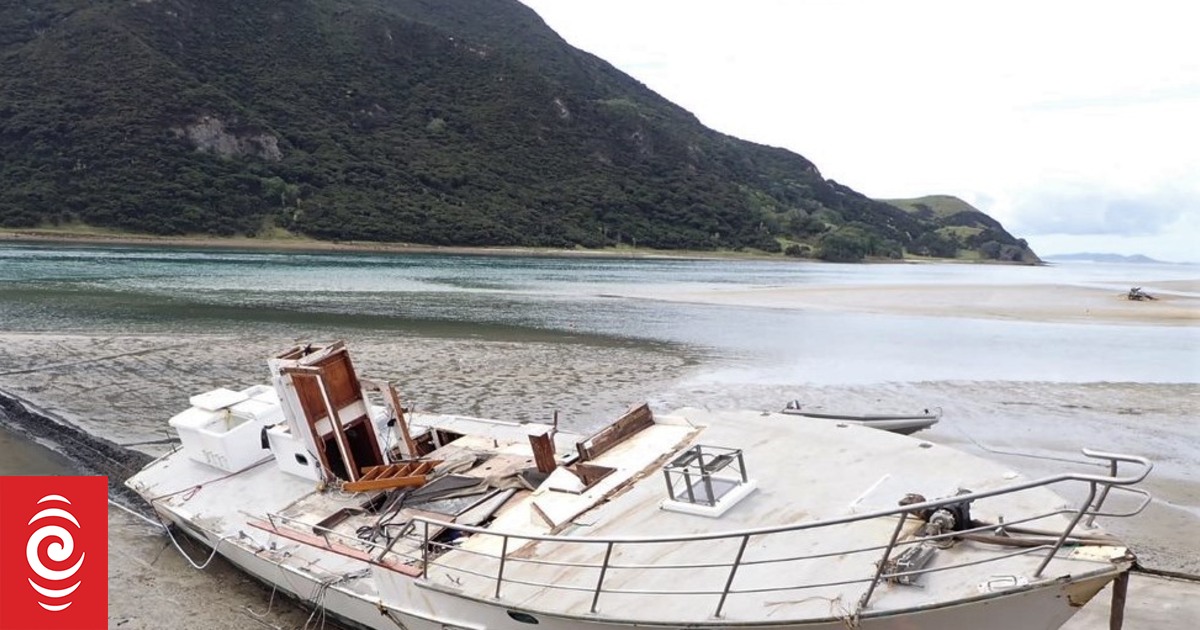
The wreck of the Enchanter on the beach at Houhora Heads, Northland, following the second salvage attempt.
Photo: Supplied / Transport Accident Investigation Commission
A lack of helicopter fuel supplies delayed the search for victims of the Enchanter maritime tragedy for more than four and a half hours.
The Transport Accident Investigation Commission (TAIC) report into the sinking of the Enchanter in March 2022 – released today – has criticised New Zealand’s search and rescue operations.
Watch TAIC chief commissioner Jane Meares and chief investigator of accidents Naveen Kozhuppakalam outline the details of the report:
The Doubtless Bay-based Enchanter was returning from a fishing charter to the Three Kings Islands, about 50km north of Cape Reinga, when it was hit by a large wave near North Cape.
The vessel capsized – tearing off the cabin and flybridge – and throwing all eight passengers and two crew into the water.
Five were winched to safety by the Northland Rescue Helicopter in extremely challenging conditions, but the bodies of the remaining five were not found until two days later.
The report stopped short of saying the men may have survived if fuel had been available in the remote Far North, but it did say the chances of survival after an accident were greater if search and rescue operations were conducted promptly.
The 104-page TAIC report makes nine urgent recommendations to the Ministry of Transport and Maritime New Zealand.
The commission has called for better application of existing maritime rules, new rules about access to lifejackets, tracking devices for commercial boats, more search and rescue training, dedicated search and rescue aircraft for remote operations, and better fuel storage for remote areas.
Chief investigator of accidents Naveen Kozhuppakalam said the cause of the Enchanter capsize was a “catastrophic, unrecoverable knock-down by an unanticipated big wave”.
“The wave rolled the vessel in an instant, forcing the superstructure and side windows into the water, exceeding superstructure design parameters. The side windows imploded and the superstructure comprising the main saloon and flybridge separated from the hull, resulting in full capsize. The hull remained inverted but afloat,” he said.
The crew managed to activate an emergency radio beacon and the New Zealand Rescue Coordination Centre initiated a search and rescue.
“The first rescue helicopter to arrive retrieved five people from the upturned hull and other flotsam. The crew of that first helicopter excelled at the high-risk task of wet winching in the dark over water. Their expertise was instrumental in saving the lives of five people,” Kozhuppakalam said.
“When that helicopter was full of people and left the scene, the survivability clock was ticking for remaining survivors. Their immediate hazards included time in the water, hypothermia, swimming ability; injuries sustained during the capsize; and pre-existing medical conditions. Nobody was wearing a lifejacket so they relied mainly on bits of boat for flotation.”
Kozhuppakalam said three of the missing men were alive in the water when last seen by the survivors.
However, a search and rescue operation involving multiple aircraft and surface vessels took almost two days to find them. By that time, they were dead.
Kozhuppakalam said delays in mustering crews delayed deployment of further rescue helicopters, and for four hours and 36 minutes, a lack of available fuel prevented helicopters searching for the remaining five people in the water.
This was partly because fuel supplies in the Far North were set up for air ambulances, not for extended search and rescue operations in remote areas.
Kozhuppakalam said it was “virtually certain” that one, or a combination, of factors – including the delayed search – had an effect on survivability.
“Limited floatation support – no-one wore, or had immediate access to lifejackets. The liferafts likely did not automatically deploy.
“Detectability: Missing people would have been hard to see in the water at night.
“The tragedy is that all of these factors had an effect on survivability.”
TAIC’s recommendations required the immediate attention of the Secretary for Transport and the Director of Maritime New Zealand.
“This report is about more than the tragic accident involving the Enchanter. It is system-wide, nationwide because the safety issues affect everyone on board a commercial or recreational vessel. And everyone on board deserves to be safe,” Kozhuppakalam said.
The report stated the Enchanter should have been able to withstand the sea conditions off North Cape at the time.
However, it was possible the vessel had strayed into the water around Murimotu Island, an area prone to occasional large waves that peaked as they entered shallow waters.
Because the capsize was so sudden no one was wearing, or had access to, lifejackets.
It was likely the liferafts had failed to automatically deploy, leaving the men to cling to the hull or pieces of wreckage to stay afloat.
The five who died in the sinking were Geoffrey James Allen, 72, Michael Patrick Lovett, 72, Richard Eldon Bright, 63, and Mark Keith Walker, 41, all from Cambridge, and Mark Kenneth Sanders, 43, from Te Awamutu.
Maritime New Zealand is carrying out a separate investigation into liability for the tragedy.
That has already led to charges being laid in the Kaitāia District Court against skipper Lance Goodhew and his company, Enchanter Charters.
Goodhew and his company face Health and Safety at Work charges of exposing passengers to a risk of death or serious injury.
The company also faces a charge of the skipper failing to have a current medical certificate, a breach of the Maritime Transport Act.
The case was adjourned and will be called again later this month.




